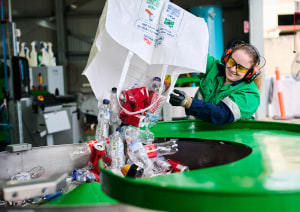Japanese electronics company Epson has launched a new robot which it says will expand the scope of automated production.
The “seeing, sensing, thinking, working” autonomous dual-arm robot is named the WorkSense W-01.
As opposed to other industrial robots, which are conventionally installed in a fixed location on a line to perform a given task, the WorkSense W-01 has been developed for easy mobility so it can be wheeled from place to place to perform assembly, transport, and other tasks.
The robot is equipped with four head-unit cameras and two arm-mounted cameras that give the robot human-like vision, enabling it to accurately detect an object’s position and orientation in three-dimensional space.
The robot arms are fitted with Epson’s precision force sensors, which are already available.
The robot is able to perform delicate assembly, transport, and other tasks that require human-like force control to avoid damaging objects.
Multipurpose hands that can grasp, grip, and clamp objects of various shapes and sizes are included as standard end-of-arm tooling.
The robot’s two 7-axis arms move like human arms. The dual arms move independently from one another to allow the robot to perform tasks that a single-arm robot cannot, such as tightening a screw in a component with one arm while holding the component in place with the other.
Three other innovations
Epson has also developed prototypes of three new models of industrial robots: the vertically articulated N6 and VT6 robots; and the T6 SCARA robot, to meet the needs of manufacturers.
Epson’s N series of compact 6-axis robots can perform tasks in tight spaces more efficiently than earlier robots due to a uniquely engineered “folding” arm.
The N6, which will join the N2 in the N series, was developed to meet the needs of customers who want to transport relatively heavy objects and transport objects over a wide area.
Floor-mounted, the N6 has a 6kg payload capacity and an arm length of 1,000mm, both considerably larger than the N2.
The N6 is ideal for tasks such as loading and unloading electronic components and automotive parts to and from test equipment or shelving and removing medical products.
It can reach a wide range of places such as high and low shelves using a smaller installation footprint than earlier 6-axis robots.
These features will enable the robot to increase productivity and the efficiency with which factory space is used.
Engineered for maximum usability and a low total cost of ownership (TCO), the 6-axis VT6 is built to automate simple, repetitive material handling tasks that humans find tedious.
Manufacturers have been reluctant to automate material handling tasks that add little value because of the expense and trouble involved in building production lines. Epson is bringing down this barrier with the affordably priced and easy to install VT6.
Drawing on the miniature controller technology it developed for its T series of SCARA robots, Epson equipped this entry-level robot with a built-in controller. Among the many possible uses for this robot are machine tending applications in which components or workpieces are loaded into and unloaded from test equipment.
Equipped with a built-in controller, the T series of SCARA robots are designed for installation simplicity and maximum usability.
They are ideal for automating simple material handling tasks. The T6 has doubled the payload capacity (6kg) of Epson’s T3 robot and thus can transport larger, heavier objects.
This robot can be outfitted with heavy end-effectors, such as dual end-effectors that can hold two objects at once, to help manufacturers increase factory productivity.
Based in Victoria, Motion Solutions Australia represents Epson in Australia.






